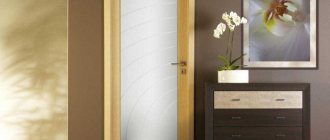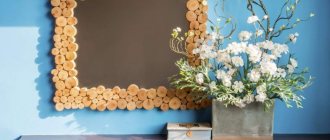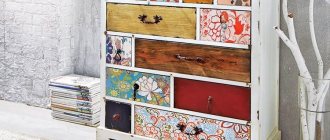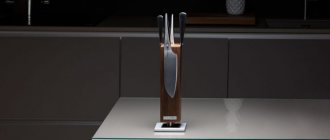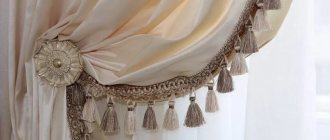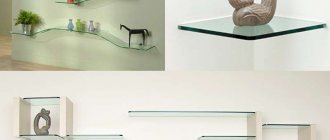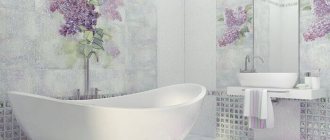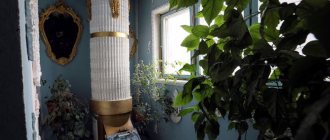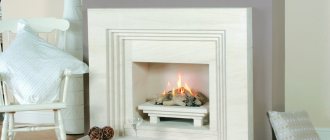Painting
The easiest way to refresh a door with minimal changes to the design of your apartment is to repaint it a new color. Choose a solid color fill if you prefer minimalism, or highlight individual parts if you like more complex artistic solutions.
In small classic rooms, light doors look good, but in laconic monochrome minimalism it can be turned into an independent accent. To do this, choose rich red, yellow, green and blue shades.
Acrylic paint is best: it is easy to work with, it is environmentally friendly, odorless, suitable for indoors and harmless to health. This is especially important when it comes to doors to a bedroom or children's room.
Photo: sauna-pod-klyuch.ru
Before painting, prepare the base, because the paint applies in a thin layer and does not hide defects. Sand and prime the surface, seal strong chips and cracks with special sealants. It is recommended to apply the paint in even stripes from top to bottom or from left to right.
If the door is textured, first paint the inserts, then the central strips, and only then the sides. And to keep the coating fresh for a long time, cover the paint with a layer of glossy or matte varnish.
Another simple painting technique is to splash paint over the surface in random spots. This decoration immediately creates a creative atmosphere in the room of an art workshop. Hard brushes, toothbrushes and even toothpicks are suitable for spraying.
Photo: grassfire.org
Trends in the arrangement of doorways
The front door is a durable purchase, and its external design must meet the practical and stylistic requirements of the owners. Often apartments are equipped with two structures, between which there is a distance equal to the thickness of the walls. Here, the decor of the front door is not of fundamental importance, and the canvas, which is internal in this pair, is designed as an ordinary interior door.
Decoration of the front door with flowers
Wooden entrance door decor
If you want the structure to merge with the adjacent walls, you should give preference to a constructivist or minimalist interior in the hallway. In this case, the door is painted in the same way as other vertical surfaces.
If the hallway area is limited in size or when too little sunlight gets into it, you can create a “light trap”: attach a full-scale mirror to the door panel. If this is not possible, even a narrow mirror strip on the door is enough - if it is located opposite the window, it will create the visual effect of the presence of an additional light opening.
Purple entrance door decor
Blue entrance door
If the hallway is quite cramped, it is worth adopting the special decorative properties of reflective and glossy surfaces: they give a feeling of full illumination, depth and airy lightness. Here you will need to install a smooth door and cover it with a colored glossy varnish that matches the range of furniture or walls.
In the interior of the hallway, for the design of which subtle graphic finishing methods were used, the relief texture of the entrance door would be appropriate. If you also correctly place the ceiling lighting, an original play of light and shadow will be created.
Wrought iron front door decor
Decorate the front door with paint
Wallpapering
In order not to paint the door leaf manually, it is enough to cover it with wallpaper to match your interior. In the living room and bedroom, ordinary paper wallpaper is sufficient, but for wet rooms, pay attention to liquid wallpaper.
Before pasting, be sure to get rid of the old coating, otherwise the adhesion will be much worse. To remove old paint, heat it with a hair dryer and use a spatula. After this, fill in all defects with wood putty and sand the surface with fine sandpaper. When choosing wallpaper, the main thing is that it matches the decoration of the walls: you can even combine several collections or use photo wallpaper. To avoid bubbles, apply glue evenly over the entire base and avoid missing areas. Carefully level the wallpaper with a roller and avoid drafts until it is dry.
Photo: odstroy.ru
Textile
In almost every home, sooner or later, the sofa upholstery is replaced and pieces of unused fabric remain, which can be perfectly used when decorating a door. Moreover, you can use not only one type of pattern, but also combine it to make the interior more diverse.
Using fabric on the canvas will also help hide any bumps or other imperfections in the canvas. Fastening the fabric occurs either using glue or using furniture clips. The good thing about using the second fastening method is that over time, the boring part of the fabric can be removed and replaced with another.
To highlight the owner’s taste and add a stylish touch to the interior, it is recommended to use lace fabric. How to decorate a door using fabric with your own hands? The work is not at all difficult, but there are still some nuances that are worth considering:
- As you know, some types of fabrics can shrink, so before attaching it to the fabric, you should wet and dry a small piece;
- When attaching fabric, you should not use PVA glue; here you need to use either casein-based glue or mastic;
- When choosing a method for decorating a door in this way, it is worth considering that fabrics absorb odors well, so it is better to use some other material in the kitchen, bathroom and toilet.
When choosing the type of fabric, you need to pay attention to its density, because if it is too thin, then when working with the material, glue will appear through it. Velvet, linen, cotton and silk are suitable for decorating a door.
Fabric decor
Pasting with fabric resembles wallpaper, but it looks more interesting due to its texture. If you have unnecessary but beautiful scraps left, you can make a real patchwork quilt on the door. This will fit interestingly into ethnic styles, boho, country or Provence.
You can fasten the fabric with glue or using special furniture staples - like upholstery on a sofa. The advantage of mechanical fasteners is that they are easy to remove to replace the boring coating. To decorate, use lace, beads, tassels, fringe, braid and any other decorative little things to your taste.
Photo: sdelai-lestnicu.ru
Leather covering
Leather covering is an alternative to fabric finishing for classic noble interiors, such as the English style. Such a door always looks expensive and luxurious in a living room or office. Moreover, it does not have to be genuine leather: now there are enough more affordable, functional and environmentally friendly substitutes.
For fastening, use glue and special rivets, which evenly fix the canvas and form elegant patterns. For decoration, pay attention to embossing, painting, fine carving, finishing with metal fittings and belts. This door will fit well into industrial styles, such as loft or grunge.
Photo: svkreal.ru
How to decorate your front door for the New Year: 10 great ways
Stencil painting
If the makings of an artist are poor or completely absent, but you really want to have your own “door to art,” you can resort to the help of ready-made stencils. They are sold in an assortment in specialized stores and are easy to use.
First, the door leaf is painted in the background color and completely dried. Afterwards, the stencil is firmly fixed on the surface, and the design is painted over with a roller. Decorating the front door in this way will undoubtedly make it clear that behind it lives an esthete and an original.
Craquelure
The craquelure effect is familiar to everyone, even if you don’t yet know the name of this phenomenon. This is the same aged network of cracks that is often used in vintage and industrial interiors. It is created using a special paint or varnish, which provokes cracking, but unlike natural wear and tear, this coating is strong and durable.
Craquelure can be one- or two-step, depending on the number of layers. Contrasting shades look good, but with each new layer, wait until the previous one is completely dry. This coating can be applied not only to wooden doors, but also to any other doors.
Photo: svkreal.ru
Preparatory activities
The decor of interior doors begins with an inspection of the surfaces. If the damage is quite small, then it may well be that no special effort is required. It will be enough to decorate the area with a child’s painting, painting or sticker.
If the surface to be remodeled is quite large, then certain preparatory steps will have to be taken.
They will be removing old paint, puttingtying particularly damaged areas, completely puttingtying the door to give the canvas the necessary evenness, removing excess materials and giving a uniform structure using sandpaper, priming for better adhesion to finishing materials.
It is better to do all this with the door removed from its hinges.
Stickers and stencils
If you are bored with plain doors, feel free to paint the canvas by hand. Can't draw? It doesn’t matter, because the simplest and most laconic floral or geometric motifs that do not require high artistic skills are in fashion.
To make the drawing even and neat, use stencils that can be printed in advance. They allow you to imagine exactly how the ornament will be positioned and not miss even the smallest details.
A bright and fashionable decoration tool is vinyl decals and stickers. Simple black silhouettes or laconic patterns are suitable for discreet interiors, and bright and colorful stickers, posters, and cutouts from comics are suitable for kitschy pop art.
Photo: demarse.ru
Film
Do-it-yourself door decoration can also be done using film. Decorating it will become a real decoration of any room. The material can be applied to metal, wood or glass surfaces.
With the help of film it is possible to hide all existing irregularities or other defects of the door. But before you start laminating the canvas, you should definitely degrease the surface and go over the canvas with a plastic spatula to release all air bubbles. When applying the film, everything must be done with the most careful movements and gradually, so that the pattern lays evenly and beautifully.
Some decorate the canvas not with a single piece of film, but in fragmentary parts, thus forming an interesting chaotic pattern.
Decoupage
Decoupage is a simple and accessible technology for finishing old doors, facades and furniture. The technique requires virtually no special skills, materials or tools. Sometimes ordinary paper napkins and glue are enough, because at its core this is a complicated applique.
Decoupage requires a perfectly smooth, sanded and grease-free surface. After this, you can paint the door with acrylic paint for contrast, but be sure to dry it. To glue the drawings, a solution of PVA with water is used, and to fix the result, a transparent furniture varnish is used.
Photo: proffstroygroup.ru
10 cool ideas on how to decorate your apartment for the New Year
Aging
This is not a mistake: to breathe new life into old doors, age them even more. There are many techniques for this: from mechanical processing to special paints and coatings.
The roughest and most striking aging for loft or country is brushing doors made of oak, ash or coniferous trees. The surface is treated with a hard metal brush, which destroys all soft fibers. The relief of the tree appears even more clearly and expressively, but this is not suitable for all varieties.
Photo: dvernoiguru.ru
Elegant abrasions for Provence or shabby chic are created using a paraffin layer. First, the canvas is painted with bright colored paint, after which it is thickly rubbed with wax or paraffin. A contrasting light or pastel coating is applied on top, which is then sanded with sandpaper. The paraffin is removed in some places and reveals the bottom layer of paint.
The second method of elegant aging is the dry brush technique, which designers borrowed from artists. It is extremely simple: take a little paint onto a thick, flat, dry synthetic brush and brush it over the base. The hairs will not leave continuous strokes and lines, forming an intermittent scratched layer.
Photo: vitdoors.ru
Autumn-spring decoration
Autumn wreaths for decoration are woven from fallen leaves, alternating with asters, periwinkle and rowan branches. A bright multi-color composition will stand out as a bright spot in the entrance space.
Composition of autumn leaves
The embodiment of spring is wreaths of fresh greenery and fresh flowers. The basis for the ring is made from bending young twigs or grapevines. Young delicate flowers and bright grass are fixed on it.
Seasonal themes can also be emphasized with artificial flowers; for such compositions, a color background that matches the season is selected.
Seasonal decoration will be unusual if combined with lighting. A diode garland is suitable for this, but you need to take care of fire safety.
DIY seasonal decorations
Mosaic
Mosaics for interior decoration are good for their uniqueness and aesthetics with ease of execution. Instead of buying a ready-made drawing, you can post a whimsical abstraction yourself. And no one else will have such doors anywhere else.
To create a mosaic, glass, ceramics, small tiles, acrylic, pebbles and shells, and any other little things are used. The main thing is to draw a sketch in advance and think over the location of all the details, because even chaotic ornaments will be neat and harmonious only if you think about them in advance.
Photo: artelle-doors.ru
Mirror
Mirror inserts in doors are one of the most functional ways of decoration. This is a good choice for small rooms, because reflective surfaces visually add volume to the room. At the same time, such a door can replace a separate wall mirror or a mirror panel in a wardrobe.
Ready-made decorative mirrors are difficult to use to decorate a door, so reflective acrylic panels are useful in this case. Their advantages are ease of processing and variety of colors. If you still have fragments of old mirrors, you can use them too - make a mosaic out of them.
Photo: nonovinkimebeli.ru
Butterfly decorations
It is impossible to take your eyes off this incredibly beautiful decoration. To make butterflies, stencils of different sizes are prepared. Butterfly wings are cut out of fibrous paper, which moves with the slightest breath of wind. The decoration looks like a flock of butterflies trying to scatter in different directions. They are made:
- black;
- colored;
- transparent.
This will be interesting to you: REVIEW: Decorating windows for the New Year 2022: 170+ Photos of Ideas that are worth using
Stained glass
Stained glass has been a classic decor for windows and doors since ancient times. This technique was used in temples, palaces and rich houses - only the subtlety of execution differed. Now there are three main options: order an individual stained glass window according to your sketch, purchase a ready-made insert, or paint the glass yourself.
Translucent acrylic paints on glass are used to apply the design. You will also need to create an outline - the illusion of metal inserts connecting the elements. But don’t paint directly on the door, because the glass should lie horizontally, otherwise the paint will flow off the surface.
Photo: legkovmeste.ru
10 best ideas on how to decorate a room for the New Year
Bohemian atmosphere
An atmosphere of bohemian charm can be easily created in your home by decorating your interior doors with rows of rivets and beads from a craft store.
Drilled holes artfully arranged into beautiful patterns are another original design idea.
Molding
To make the simplest and most budget door luxurious and elegant enough for classic interiors, use molding. These are ready-made elements that imitate stucco molding, bas-reliefs and other decorative inserts.
The simplest molding is made of polyurethane or foam, so it can simply be glued or mounted on liquid nails. And to make a beautiful aged door, be sure to paint it over the top and use contrasting colors or gilding for details.
Photo: evrookna-mos.ru
Decorating doors using liquid wallpaper
Liquid wallpaper is similar to decorative plaster. They include paper, sometimes glitter, adhesive and cellulose. You can obtain a mixture for application by adding water. To decorate one door, half a pack of liquid wallpaper is enough.
The composition must be prepared before use. Pour it out of the bag into a plastic bowl, add water and leave for a day so that the wallpaper swells and the adhesive is activated. Then, using a gentle spatula, apply the mixture to the grease-free door leaf. It is better to first remove the door from its hinges and dry the finished product outside.
DIY old door decor - photo
This is not a complete list of options that you can implement yourself. Don’t be afraid of experiments and imagination, because the old door has nothing to lose in any case. And we offer you even more photo ideas for inspiration!
Photo: waysi.ru
Photo: dekormyhome.ru
Photo: evrookna-mos.ru
Photo: mykaleidoscope.ru
Photo: artlook.cz
Photo: odstroy.ru
Photo: vsykosmetika.ru
Photo: domoholic.ru
Photo: instagram.com
Photo: manoletebcn.com
Photo: happymodern.ru
Photo: zen.yandex.ru
Photo: skillofking.com
Photo: podelki.org
Photo: runtedrun.com
Photo: homelikeyou.ru
Photo: sissyfeida.com
Photo: decorinspiratior.com
Photo: acnnhome.com
Photo: homelikeyou.ru
How to update wooden interior doors: instructions
First, you need to think through the design of the future door in detail: it should fit well with the overall style of the room, combine with the furniture, floor, and decor. There are many simple ways to update a door: stick a film, veneer it, or apply paint or stain. If desired, you can use more complex techniques that turn an old door into a work of art.
Painting, varnishing and staining
The easiest way to update your doors without changing them is to paint them a new color. It is only important to choose high-quality paint that matches the color. This can be done from photos in manufacturers’ catalogs to match the shade of the floor or furniture. Most often, doors are painted with nitro enamel, acrylic or alkyd enamel. Acrylic paints are considered completely safe, while others emit a pungent odor that disappears only as the layer dries. It is advisable to carry out coloring in the fresh air.
Acrylic paints have a rich palette of shades, give a noble matte finish, and do not smell. It is recommended to apply a special furniture varnish as the second layer after the acrylic product, which has protective properties and increases the service life of the paint. Application is done with a roller or brush. To prevent brushes from leaving lint, they are pre-soaked in water for several hours and then combed out. Before any paint, it is recommended to coat the door with a wood primer, so the paint and varnish material will lie smoothly, without drips or stains.
In addition to painting, you can varnish the door. You should choose the appropriate remedy from the following varieties:
- acrylic,
- alkyd,
- polyurethane,
- nitro varnishes.
Before applying the varnish, a primer is also used, adding to it an antiseptic against rotting and mold. To make the transitions of varnish strokes unnoticeable, the product is applied with quick movements in a cross direction.
Stain is another option for an inexpensive and very beautiful coating for an old door. It is absorbed into the deep layers of wood, giving it a pleasant color and beautifully highlighting the structure of the material. After staining, it is also recommended to apply 1-2 layers of wood varnish.
Veneering
To completely renew the door and give it an expensive, elegant look, natural veneer is used. With its help, you can refine even cheap canvases made from pressed sawdust. Procedure for working with veneer:
- lay the door on the stools horizontally,
- start facing the canvas from the middle, moving towards the edges,
- lubricate a small area with special glue, apply finishing material, press,
- roll well with a roller,
- It is advisable to heat the surface with a construction hairdryer, and then carefully roll the veneer again - this will make the connection between the finish and the veneer itself more reliable.
After gluing the entire door, allow it to dry completely, then apply protective varnish or wax.
Self-adhesive film
There are many options for film on sale that imitate wood in color. It is easy to stick, hides defects in the base, and gives a more noble and beautiful look to the canvas. The procedure is as follows:
- cut the film according to the required size using a sharp knife,
- remove the protective layer from the wrong side, but not from the entire cut, but only 3-4 cm from the top,
- apply the film to the door, smooth it with a rubber spatula (you can use a regular rag instead),
- start tearing off the rest of the protective layer, not forgetting to immediately expel any air bubbles from under the film,
- trim the film at the corners,
- install fittings.
Photo wallpaper or vinyl
A piece of vinyl with a photo print made by an advertising company, or photo wallpaper of the required size will also help decorate the door, giving it a completely new look. It is important to purchase only washable photo wallpaper, because the door leaf can get dirty and will have to be washed regularly.
To glue photo wallpaper, you can use high-quality PVA (it is better to take carpentry compound). It is necessary to thoroughly lubricate the door with glue, press the finishing material well, smooth and level it. Of course, you first need to try on the photo wallpaper or vinyl dry to make sure that their size matches the dimensions of the door.
Wallpaper with moldings
Such an unusual decor option is often offered by designers when decorating a room in a classic style. With the help of vinyl or non-woven wallpaper and polyurethane moldings, you can create a bright accent in the room and enhance the style of the design. The background can be plain, patterned, saturated or pastel in color - at the request of the customer.
First you need to measure out the required piece of wallpaper. Then PVA wood glue is applied to the prepared, leveled door, finishing material is applied, and its surface is leveled with a rubber roller or rag. Air bubbles are immediately expelled with a plastic spatula from the center to the edges. It is advisable to buy wide wallpaper so as not to make joints. If there are joints, you will have to carefully adjust the two canvases to each other. The edges of the wallpaper are trimmed immediately before they get wet. Drying time is a day, then you can start gluing the moldings:
- make markings for platbands on the wall with a simple pencil,
- cut the moldings to the required length (there should be 3 pieces),
- cut the moldings at an angle of 45 degrees - these will be the corners at the top of the door,
- Lubricate the back surface of the pieces with PVA or liquid nails, and glue them in place according to the markings.
Drawings and paintings
Drawing on the door surface has many advantages over other finishing methods. The appearance of the finished door will be unusual, exclusive, it can “fit” into absolutely any interior style. Other advantages of painting on the door leaf:
- ease of execution,
- the ability to use stencils if you have no artistic abilities,
- large selection of colors and materials.
The prepared door should be well degreased with alcohol. Next, a wood primer is applied in 2 layers, which will allow the paint to lie flat, without stains or drips. Then you need to make markings and apply an ornament or design. The door must be divided into zones so that the drawing is done accurately and correctly. When ready, paint individual elements of the picture in the desired colors with acrylic paints. Apply at least 2 layers of paint. To give a vintage look, the contours of the design are outlined in contrasting tones.
Decorating doors using decoupage technique
To decoupage, the door does not need to be removed from the jambs. If it does not have an old coating, it is enough to simply wash and dry the product, prime it with 1-2 layers. The opening should be sealed with construction tape. Soak the decoupage card in water for 12 minutes, remove it, and wipe off excess moisture with a rag. Remove the protection strips and attach the drawing to the pre-lubricated PVA door.
As in the case of wallpaper, the image should be carefully ironed, air bubbles expelled, and all wrinkles removed: otherwise it will be uneven and ugly. After complete drying, the surface of the door is coated with acrylic-based varnish in several layers.
Antique decoration
In vintage, retro and a number of other styles, various items, souvenirs, and antique finishes are very popular. Ready-made aged decor is rarely found in stores, but you can make it yourself. To give the door an original look, the craquelure technique is used - a two-layer application of varnish.
First you need to choose the right materials. Purchase two varnishes with different compositions and drying times. One of them should be a special wood varnish for craquelure; even a beginner can work with it, and there are detailed instructions on the package. The second varnish is bitumen, which has o.
The procedure is as follows:
- apply craquelure varnish to the pre-prepared door (use white or another light shade),
- after drying, a layer of bitumen varnish of a darker color is applied, which will enhance the contrast.
In the craquelure technique, you can also use a dark base varnish, but then, instead of bitumen, acrylic paint of the required shade is used as a second layer. After drying, the craquelure varnish becomes covered with a network of cracks, which gives the door a vintage look.
Decor with stencils
This technique is used for doors that have glass inserts. A picture or pattern is sketched on paper and cut out along the contours. The glass is degreased, cleaned, the drawing is leaned against it, and outlined on the back side with a marker. Then you can start drawing the image with acrylic paints, but from the front side. Afterwards you need to let the picture dry completely.
Artistic painting
Drawing on a door can involve the use of different artistic techniques. For example, first the canvas is completely dyed and only then a drawing is made on it in contrasting shades. Also, the picture can go beyond the door and continue along the walls: it will look unusual and very impressive. It is possible to apply paint to the door using a sponge, a spray can, or strokes. It is allowed to use interesting techniques - glazing, multi-layered strokes.
Creating an unusual texture
An original way to restore a door is to give it an interesting texture. In addition to the effect of artificial aging, which is obtained using craquelure varnish, you can use another technique. A lighter shade of paint is applied to the base, then a second layer is applied with a soft sponge, carefully blotted. Using this simple technique, spotted surfaces or “steel wool” type bases are obtained. There are also special paints on sale, thanks to which you can create the appearance of a canvas or a slate board from an ordinary door.
Patchwork for doors
A door made using this technique will fit well into any interior. To decorate it, you can use scraps of fabric, newspaper clippings, magazines, photographs, pieces of leather, and other items that go well with each other. It is better not to use this method for a bathroom or other damp room - the collage will quickly turn yellow and begin to become moldy. Patchwork is ideal for interior doors in the bedroom and living room.
As for the fabric for patchwork, it must be dense, not fraying at the edges, and, if necessary, have a small repeating pattern. The cuts can be overlocked, although this is not necessary. Fabrics and laces that are too light should not be glued in the area of the door handle - they will soon become dirty. You will also need PVA, a furniture stapler and staples for the job. The procedure is simple:
- prime the door
- apply PVA glue to the door area,
- attach scraps and other materials to create a picture,
- press well, roll with a roller,
- let the collage dry well,
- attach heavy elements to the door with a stapler,
- the finished object can be coated with furniture varnish.
Door lamination
For lamination, a special self-adhesive film is used. Unlike factory lamination, home lamination has a shorter service life due to the lack of the necessary pressing equipment. Externally, the result will be no worse than that of professionals.
First you need to buy a special film, which is sold in furniture component stores. The finishing material is glued onto a flat, smooth, grease-free door after removing the protective coating (first remove only its upper edge by 3-5 cm). After pasting the entire surface and expelling air bubbles with a plastic spatula, the film is heated with a construction hairdryer and rolled well. This will help the glue adhere more reliably to the surface. After the glue has dried, the product will be ready for use.
Glass inserts
To update the look of an old door, you can change the glass yourself or change the decor of the old one. Stained glass technology gives a particularly interesting effect. To complete it you will need special stained glass paints, a marker, brushes, and a finished sketch.
You need to work this way:
- remove the glass or the entire door, lay it horizontally,
- on the back side of the glass, draw the contours of the future stained glass window and all its sections,
- paint contour lines on the front side,
- after drying, fill the empty spaces with the desired shades,
- if desired, glue decor onto the paint that has not yet hardened: rhinestones, stones, pieces of colored glass (you can then circle them with a black marker),
- wait for the paint to dry completely,
- install the glass in its proper place.
Stained glass techniques are also used on the canvas itself. It is allowed to create the effect of a stained glass window with paints, as well as to cut holes in the door and insert pieces of multi-colored glass into them, the result will be a beautiful, exclusive composition.
Textile
Textile finishing is used infrequently, and in vain. This is a unique and easy way to dramatically change the look of an old door without breaking the bank. You need to buy fabric and prepare a piece of the desired size from it. A piece of fabric must be glued to the door using double-sided self-adhesive tape. It is important to remove all folds immediately, because after that it will be very difficult to peel off the tape.
It is better to avoid light colors in textiles: they get dirty quickly. Fabric with images of cartoon characters and fairy tales is ideal for a children's room. If desired, the finish can be replaced with a new fabric you like or one that is more suitable for the main style of the room.
